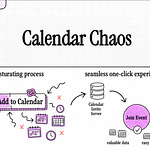Introduction: The Hidden Flaw in Your Event Marketing
For years, the “Add to Calendar” button has been a staple of event marketing. We add it to our emails and landing pages, assuming we’ve made it easy for our audience to remember our webinar, product launch, or sales promotion. But there’s a hidden flaw in this ubiquitous tool.
For marketers, these buttons are a “fire-and-forget” solution. Once a user clicks and downloads the static file, the connection is severed. You can’t push updates for a time change, you can’t natively track RSVPs, and the user experience is fragmented. It’s a dead end.
There is a fundamentally better approach—one that transforms the calendar from a static entry into a dynamic, two-way communication channel. This article will unveil five surprising truths about modern calendar invitation technology that challenge the status quo of “Add to Calendar” links and reveal a more powerful way to engage your audience.
1. The “Add to Calendar” Button Is a Dead End. A Real Invite Is a Conversation.
The “Add to Calendar” button is a one-way, one-time data drop. It provides the user with a static .ics file, and once downloaded, there is no persistent connection between you and the attendee’s calendar. You’ve given them a piece of information, but the conversation ends there, leaving you with no way to follow up or adapt.
A native calendar invite, sent via a proper calendar invite server, is entirely different. It establishes a live connection that remains active throughout the entire lifecycle of the event. This establishes a direct line of communication from your system to the attendee’s actual calendar.
Establishes a direct, two-way channel to the attendee’s calendar for the lifecycle of the event.
While one method delivers a static file, the other creates a live, persistent communication channel. This distinction fundamentally changes the relationship between the event organizer and the attendee, turning a simple reminder into an active dialogue.
2. Event Updates Can Be Seamless, Not a Logistical Nightmare.
With “Add to Calendar” buttons, updating an event is a recipe for audience confusion. If a time, link, or location changes, your only option is to send a new email blast and pray that users see it, manually delete the old event, and add the new one. It’s a logistical nightmare that undermines the credibility of your event.
A native calendar invite server makes updates seamless. The organizer opens the event in their own calendar client (such as Google Calendar or Outlook) and makes the necessary changes. That update is then automatically pushed to everyone who has already accepted the invite. This guarantees attendees have the correct information. Even better, if an event is canceled, the cancellation is pushed directly to their calendars, automatically removing the “ghost” event and eliminating confusion.
3. Your Own Calendar Is the Ultimate Control Panel.
With a modern calendar invite system, the organizer’s workflow is radically simplified. You can create, update, and cancel events—all from the single, familiar calendar client you use every day. This isn’t just a new interface; it works by leveraging the universal, built-in functions of all calendar clients—Create, Read, Update, and Delete (CRUD)—to establish a direct messaging pipeline. Your calendar becomes the command center.
This stands in stark contrast to the old method, which forces you to log into multiple vendor platforms to generate buttons, create separate RSVP forms, and manage changes. This shift to using your own calendar as the control panel significantly simplifies event management and eliminates the need to switch between fragmented platforms constantly.
4. You Can Get Real RSVP Data—Without a Web Form.
Native calendar invites automatically collect “calendar receipts.” When an attendee receives a real invite, the “Yes, No, Maybe” buttons are built in. Their response is sent directly from their calendar client back to your system, providing you with immediate and accurate RSVP data.
This is vastly superior to the “bolt-on” workaround required by “Add to Calendar” buttons, where users are redirected to a separate landing page to fill out an RSVP form. That process adds friction and disconnects the RSVP from the actual calendar entry. By collecting Y/N/M responses directly, you “own the signal.” The calendar becomes a “live intent signal,” providing a direct line into audience intent that allows for more intelligent segmentation, more relevant follow-ups, and ultimately, higher conversion rates.
5. A Calendar Event Is a Dynamic Content Object, Not a Static Reminder.
This technology goes far beyond simple meetings. Consider its application for the entire 272-game NFL schedule. In a demonstration project, each game was created as a dynamic calendar invite, turning a simple schedule entry into an evolving content object.
This was achieved through data enrichment, where the event was updated with new, contextual information throughout its lifecycle. A single game invite followed a three-stage evolution:
• Before the game: The invite contained the core event details, like teams, kickoff time, and venue.
• During the game: The calendar event could be updated with live scoring information, pulled in real-time from a public data source like the ESPN API.
• After the game: The event was updated one last time to show the final score and include a link to game stats.
This transforms a calendar entry from a static placeholder into a data-rich piece of content that remains valuable, helping the event evolve with the user over time.
Conclusion: Rethink the Calendar
It’s time to move beyond the obsolete “Add to Calendar” button. You’ve seen how to transform a dead-end data drop into a live conversation, a logistical nightmare into a seamless update, and a static reminder into a dynamic content object. We must stop seeing the calendar as a simple scheduling utility and start recognizing it as a powerful, direct-to-consumer communication platform.
Now that you know a calendar invite can be a persistent communication channel to your audience, what will you build with it?











